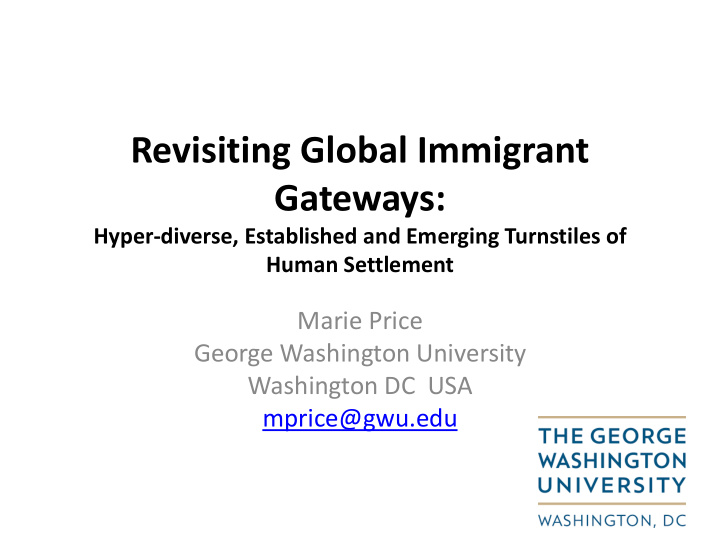



Revisiting Global Immigrant Gateways: Hyper-diverse, Established and Emerging Turnstiles of Human Settlement Marie Price George Washington University Washington DC USA mprice@gwu.edu
International Migrant Stock as % of the Total Population World Developed Regions Developing Regions 11.2 10.7 9.7 8.7 7.9 7.2 3.3 3.2 2.9 2.9 2.8 2.8 1.7 1.7 1.6 1.5 1.4 1.4 1990 1995 2000 2005 2010 2015 Source: UN, Population Division, Trends in International Migrant Stock: The 2015 Revision
Where are the Major Urban Immigrant Destinations of the World and What Do the Tell us? • Metropolitan areas of over 1 million people • Number of foreign-born residents and countries of origin • Based on Census data from over 50 countries at the Metropolitan Scale, since 2000 • Immigrants are increasingly larger portion of urban populations, especially in the developed world Literatures: Global Cities; Globalization from Below; Immigrant Gateways; Immigrant exclusion/inclusion
Data Challenges • Data collected irregularly, often by decade, and different years • Defining urban areas consistently • Different definitions of foreign-born or migrant stock • Not all countries publish data on the foreign- born at the sub-national scale
Gateways • Critical entry points that draw from a wide range of sending countries • Facilitate cultural exchange and must address immigrant inclusion • Nodes for the collection, circulation, and dispersion of goods, capital and people. • Some are Global Cities, most provide important globalizing links, especially with countries of origin • Localities of opportunity but also exclusion, vulnerability, and segregation
U.S. Gateway Typology Singer, 2015
Hyperdiversity • A gateway in this study has at least 11% of the total population is foreign-born, • (2) no one country of origin accounts for 25% or more of the immigrant stock • (3) immigrants come from all regions of the world.
Toronto 2.5 million Foreign Born, 46% of the total population. Vancouver 913,000 Foreign-born, 40% of the total population
Turnstiles • A rotating cast of immigrant labor often allowed in temporarily or without authorization. • Immigrants regularly move through these urban turnstiles, often in highly precarious and temporary conditions. • This would include immigrants and refugees, and it is likely their numbers are growing.
Permanent Temporariness
Established • Established (or Continuous) cities that have been attracting immigrants for a half-century or more. These would include the obvious cities such as Los Angeles, London, Hong Kong, or Buenos Aires
Emerging Gateways • There also are Emerging gateways, that saw their growth in the 1990s onward, as globalizing trends reorganized the world map and countries experiencing labor shortages set up mechanisms to recruit foreign workers.
Foreign-Born in Shanghai 200000 180000 160000 140000 120000 100000 80000 60000 40000 20000 0 2001200220032004200520062007200820092010201120122013201420152016
Source: https://gum.columbian.gwu.edu/
Gateway Cities with over 1 Million Foreign-born Cities Dropped: In these 22 cities are over 45.5 million foreign-born residents Moscow? which represents 18% of the Singapore Foreign-Born Stock in 2015 Cities Added : according to the United Nations. Abu Dhabi Nearly, one-in-five immigrants Kuwait City Madrid are in these cities. Johannesburg Metros of nearly 1 million foreign-born Buenos Aires, Mecca, Vancouver
Source: https://gum.columbian.gwu.edu
84 million immigrants or 34% of the foreign-born stock in 2015
https://gum.columbian.gwu.edu/
Recommend
More recommend